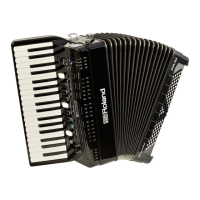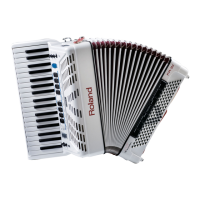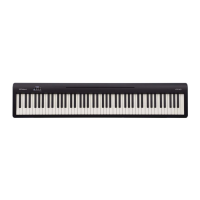Menu Options
84
Thresh Max
Thresh Min
The harmonic bars use the
settings made on page
p. 82.
Harmonic bars whose level
can still be increased become
louder.
All harmonic bars use
maximum level.
NOTE
As stated above, the “Crescendo” eect will not be audible if all
harmonic bars already use the maximum level.
7.3 VTW Upper (Right Hand Organ)
After editing the organ sound, you can decide to
name it for easy identication. Your sound resides
in the “User” memory.
After editing the organ sound, you can decide to
name it for easy identication.
The FR-8x suggests the name of selected register.
1. Use the [DATA/ENTER] knob to enter the desired name.
See “How to type a name in FR-8x” (p. 31).
2. Press [EXIT/JUMP] button to exit from the selection.
8. Orch Bass Edit parameters
The parameters of the “Orch Bass Edit” group allow you to edit the
Orchestra and VTW Organ of the Left Hand Bass section. See “Bass
and Chord System (BASS & CHRD)” (p. 34) for details about the
selection of the Orchestra section.
The parameters can be saved to the selected Set.
Press [UP] and [DOWN] simultaneously to select the value that is
indicated as “Default setting”.
Introduction to Orchestral Bass Parameters
All changes you make here apply to the last Orchestra Bass register
you selected. So be sure to select LEFT HAND [ORCH BASS] button
and press the register whose settings you wish to change before
selecting and editing any of the Orchestra Bass Edit parameters. You
can, however, decide to save your settings to a dierent register if
you realize that you’ve been editing the wrong one.
IMPORTANT NOTE
The FR-8x internal memory remembers your settings while the
FR-8x is switched on. While editing, there is no absolute need
to save your settings. Be aware, however, that all changes are
lost when the FR-8x is switched o.
See “How to Save a Set” (p. 42) to save your changes. Also
be sure to read “Important remark about saving your settings”
(p. 70).
8.1 Tone Selection
This parameter group allows you to assign the
desired orchestral or organ sound (VTW) to the
selected register.
Parameter Value Explanation
TONE
For details regarding
this settings refer to
the“Tone & Drum Kit List “
supplementary manual.
Download it from the
Web:
http:/ www.roland.com/
manuals/
This parameter allows you to
assign the desired orchestral and
VTW Organ sound to the selected
register.
The VTW Organ Sound is the rst
in the Orchestra Tone List.
8.1 Tone Selection (only for VTW Organ
Tone)
If you selected a VTW Organ Tone (It’s the rst in the list):
The following page appears:
Two parameters are added in the “Tone Selection” page:
Parameter Value Explanation
VTW PRESET Usr, P1~P16
Select the Organ preset that you
wish to assign to the selected
register.
• “Usr” User preset (Only If you
edited a VTW preset)
• “P1~P16” 16 Organ preset (Not
editable)
EDIT
Rotate the [DATA/ENTER] knob to select this eld and
rotate knob to select “On”.
The “VTW PEDAL“ edit page is shown:
To detailed information to edit the selected preset see
“Editing the selected organ sound” (p. 82).
8.2 Tone Control
These parameters group allow you to adjust the
some useful parameters.
Parameter Value Explanation
LOWEST
NOTE
E, F, F#, G, Ab,
A, Bb, B, C
Default: E
This parameter allows you to specify the
lowest note the selected sound can sound.
About “LOWEST NOTE”
The ORCHESTRA BASS sounds (like the orchestral sounds of
the treble section) are PCM waveforms (samples) of acoustic
instruments. Each acoustic instrument has a set range: it cannot
sound notes below or above that range.
A normally tuned 4-string bass guitar allows you to play a low E, but
not the D below it, for instance:

